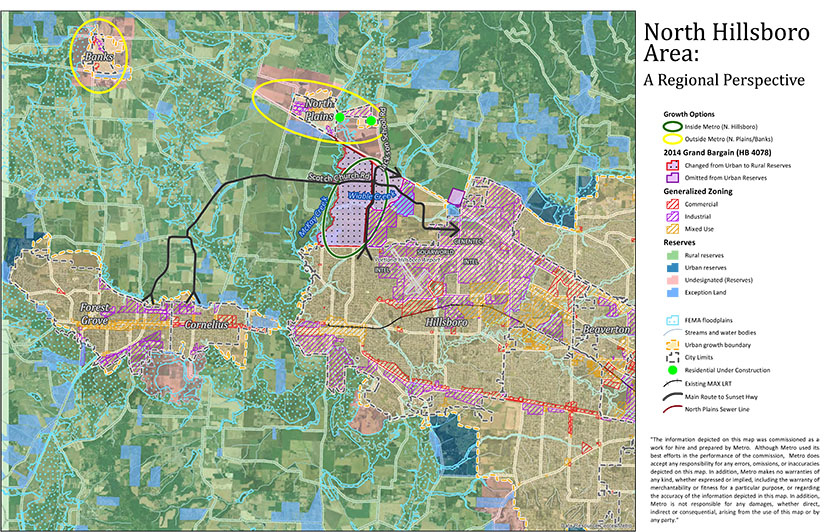Northwest Hillsboro
ALLIANCE
Advocating Common Sense Land Use
A Regional Perspective
This map depicts several key attributes and rationale, at a regional scale, for including NWH in the Metro Urban Reserve (UR). It also depicts some of the negative consequences of policies that have the effect of pushing growth to locations outside the contiguous Metro UGB.

Growth outside the Metro UGB
North Plains and Banks
Notice how close the cities of North Plains and Banks are to NH. Also, notice the substantial UGB areas and “undesignated” land surrounding both cities. Currently, substantial urban development is occurring in North Plains on historical farmland. This development is in the form of significant sized residential subdivisions on the corner of West Union and Jackson School Roads. Banks recently approved the annexation of over 200 acres for residential development on its western boundary.
All of this development, and the potential for future development, are outside the contiguous Metro UGB. This development is at relatively low density levels, is adjacent to farmland on most sides, is not “distinctly” separated from agricultural land by natural or major highway boundaries; and, is enhanced by relatively low land costs and development fees.
Scappoose and Columbia County
Cornelius Pass Road connects directly to one of the State’s largest concentration of high paying jobs. Travel time to Scappoose and Columbia County is within easy commute distance to these jobs in NH. Should development options be excessively constrained in the NH area this more distant “urban” land will be attractive to developers and new home owners. Land in Columbia County is readily available and relatively low cost.
Negative Infrastructure Impacts
Transportation
The transportation infrastructure to serve these urban communities outside Metro will:
- traverse agricultural land
- be more costly to provide than closer in development
- not be readily serviced by transit nor provide realistic transit oriented land use development
Sanitary Sewer
Currently North Plains is served by a pressure line that traverses farmland and is routed down the Sunset Highway to Brookwood Ave. The Jackson School Rd. to Evergreen Rd. pressure line has been abandoned but is still in place. This has two negatives…it is not gravity service and it impacts farmland.
Regional Trail System
With North Plains being separated from the contiguous Metro UGB, new additions to the region’s trail network would have to be placed on farmland. This type of use is not practical, conflicts with farm practices, and is highly unlikely to be implemented.
Tualatin Valley Irrigation District (TVID) and McKay Creek
TVID is a highly functional irrigation system that brings reliable irrigation water to much of western Washington County. This system allows for much broader crop options and greatly increases crop yields for some crops. The value of this system is reflected in land values with land in the District selling at nearly twice the value as “dry land” agriculture land outside the District. The dividing line between irrigated land inside the District and “dry land” property is McKay Creek. Growth on land to the west of McKay Creek will erode the land base for TVID.
It is worth noting that the western boundary of the City of Hillsboro is McKay Creek. Should NH be added to the Urban Reserves (UR) this same geographic delineation would simply be extended north to its intersection with the Sunset Highway; thereby, establishing a clear and “distinctive” boundary for years to come between urban land and agricultural land. None of the “dry land”, east of McKay Creek, is inside the TVID.